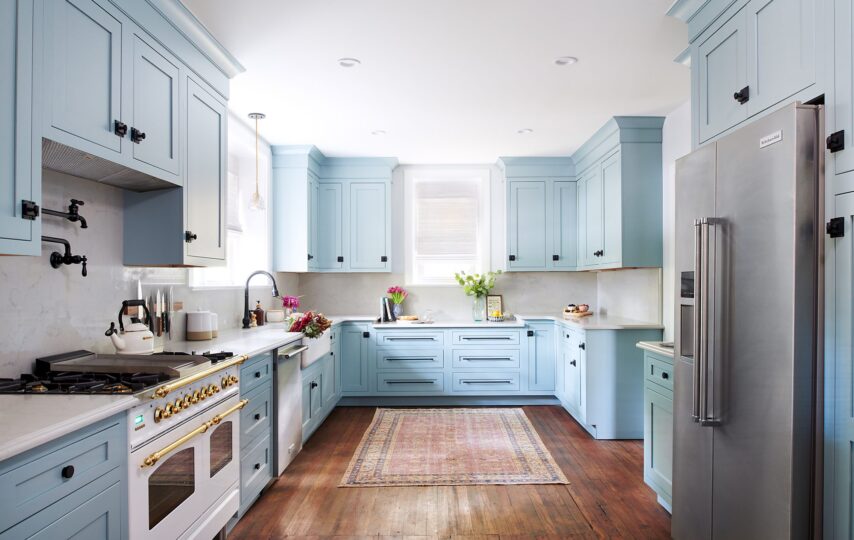A kitchen remodel is a big endeavor, and one of the most important aspects of designing yours is choosing the right palette. The key to creating a cohesive look that’s also unique to you is picking out the right paint colors, fabric patterns, lighting fixtures and more. Of course, there’s no such thing as “one size fits all” when it comes to designing your dream space—but here are some tips for helping you create your perfect palette by CabinetIQ – kitchen remodeling provider in Austin:
Search For Inspiration
You may think that the first step in choosing a kitchen palette is to walk through every room in your house and decide what colors you like. This isn’t wrong, but it’s also not very productive. If you’re going to spend time painting each wall of your new home a different color—or even one wall—it’s important to do some research first. The best way to do this is by searching for inspiration photos on Pinterest or Instagram. Here are some places where you can find the perfect pictures:
- Look at kitchens (and bathrooms) that already exist inside homes you like
- Look at photos of homes you like
- Take photos of kitchens (and bathrooms) that already exist inside homes you don’t like
Decide on Your Focal Feature
It’s important to decide on a focal feature that will make your space feel the most impactful and functional. The focal point should be the most visually impactful, meaning it should draw attention to itself and help define the color palette you choose. It can also be the most functionally helpful, such as where you want to put your range or refrigerator.
It’s also important to factor in how much time-consuming work is required for each feature because this will impact what kind of project you can tackle yourself versus hiring someone else do it for you.
Once these factors are determined, they will help narrow down which choices would be best suited for your home remodel so that both time and money are well spent!
Select Your Base Color
- Select a color that will last. Choose a color that is durable and easy to clean. If you are choosing lighter colors, make sure they won’t show grime easily, such as white and light pastels.
- Be picky about the type of paint you use. Not all paints are created equal! I recommend using Valspar Signature Semi-Gloss Enamel or Benjamin Moore Regal Select Semi-Gloss Enamel for kitchen cabinets because they have great coverage, durability and washability—and look good on both light or dark colored cabinets! The same goes for your countertops—I recommend using Valspar Signature Enamel unless you want something darker like Benjamin Moore’s Regal Select line which has more depth in its finish allowing it to stand out better against light colored cabinets/countertops without being too dark/intimidating looking off-white like most other brands’ lines (which typically come across as yellowish).
Choose 2 or 3 Complementary Colors
The idea of using complementary colors in your kitchen remodel palette is not a new one. In fact, it’s been around so long that it’s hard to imagine a time when people didn’t choose their paint colors based on whether they were complementary or not. The idea is simple: by choosing two colors that are opposite each other on the color wheel (i.e., red and green, blue and orange) you get a balanced look that has a sense of unity while still providing contrast between elements like cabinets, appliances and countertops.
However, there are rules for using this technique effectively—rules that can help ensure success in bringing together contrasting hues as part of your new kitchen design:
- Try three instead of two colors if you want to add more interest but still keep things relatively simple. If you select all three from one family (e.g., blues), the way they interact with each other will be far less obvious than with 2 or 4 different hues competing for attention at once
Pick Your Accent Color
[accent colors] are used to draw attention to certain areas of the kitchen, highlight a specific feature and draw the eye from one part of the kitchen to another. An accent color can also be used as a focal point in your kitchen design. For example, you may want an accent color on your cabinet doors or on your countertop.
Mix It Up With Texture and Patterns
One of the best ways to add interest and depth to your kitchen is with texture and pattern. Texture adds visual interest, especially if it contrasts with other elements in the room. For example, a glossy finish will look more striking against a matte countertop or wall color. Pattern also enhances a space by adding visual interest when used correctly; however, too much pattern can be overwhelming!
Achieving a sense of depth in your kitchen is simple: use textures and patterns that contrast each other! Patterns on counters are great because they create an eye-catching focal point while also adding warmth and coziness to the space. A wall with a bold stripes adds depth similarily by drawing attention upward towards higher ceilings or skylights which creates more spaciousness—a major benefit in small kitchens!
Mix Up the Palette As Needed
An important part of designing your kitchen is to make sure that you love the colors. While it’s helpful to follow trends, you should always feel confident in your decisions and that means making sure the colors work for you. With this in mind, we recommend not only sticking with one palette but also mixing up your colors as needed.
If you like something but want to modify it slightly, consider adding a new color or changing one of the existing ones without starting over from scratch. For example: if peach isn’t quite right on its own and looks better with some red thrown in there (like Pepto Bismol), then use some red paint instead of another shade of peach! You could also add a darker shade of green instead—it will still work well because they’re both earth tones but will give off different vibes depending on how much darker it is compared to the rest of them (softer vs bolder). Another option would be changing out cabinet doors; if cabinets are too yellowy then buy black doors instead since they’ll give off more contrast than white ones would have done alone here.”
A cohesive palette is one of the most important aspects of designing a kitchen.
Cohesive palettes will help you to create a cohesive look that is consistent throughout the space. Your kitchen remodel palette should be based on the existing elements in your kitchen, including cabinets, flooring, countertops and appliances. By choosing a cohesive palette for your kitchen remodel project you will achieve an overall design that looks like it was created by one designer or architect with one vision in mind. Connect with the experts of CabinetIQ – kitchen remodeling provider in Austin to brainstorm on designs.
Cohesive palettes are not only pleasing to the eye but they also help to make spaces feel more unified by creating a sense of balance between different elements within them such as color choices used on walls and floors inside rooms so there’s no need for contrasting colors which could prove distracting if used too heavily throughout each area of this type (for example).
Conclusion
As you can see, there is no shortage of options with CabinetIQ – kitchen remodeling provider in Austin when it comes to choosing a kitchen palette. If you’re looking for some inspiration for your next project or are simply curious about how other homeowners have made their kitchens shine, check out our previous blog posts on the topic!



